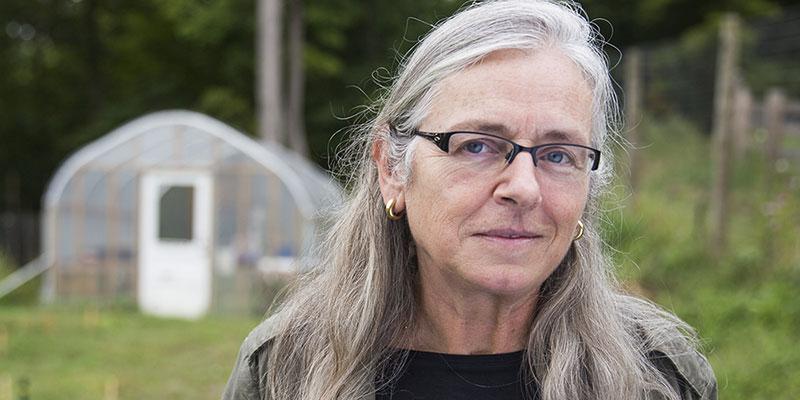
What is the Future of Meat?

Dyson Professor and Chair of the Department of Environmental Studies and Science E. Melanie Dupuis, PhD, is one of the tri-state area’s foremost experts on environmental politics and policy. We had the opportunity to ask her a few questions about the Dyson Institute of Sustainability and the Environment’s Resilience Summit, which will bring together leaders, academics, and activists to discuss and debate the complicated issues surrounding meat consumption.
Why was The Future of Meat? chosen as a topic for this year’s Resilience Summit, and why should it matter to people?
Dyson has been holding Resilience Summits every few years. It began with Hurricane Sandy and the two summits about coastal resilience and sea level rise. But the last summit, on the water crisis, expanded the idea of resilience and now we are looking at food for this summit.
The idea of the Resilience Summit is to highlight a resilience topic that is currently under discussion and to bring together people who can address the various perspectives on that issue. Needless to say, with the current rise of plant-based meat, new ways of livestock production and how both address climate change, it was important to bring people together to talk about these different paths to the future of protein consumption: should we continue to eat meat as a protein? Or should be go with plants? Or with lab-created products like the Impossible Burger?
How has public perception of meat eating changed in the 21st century? How do you anticipate it will continue to change?
It depends on who you are talking to. For my Environmental Studies and Science students, the question is always: should I go vegan? Many of my students became vegan after watching Cowspiracy. One of my jobs as a professor in this department is to make sure they understand the information that is presented to them, offer them various different points of view, and give them the tools to sift through that information. A few years ago, one of my policy students came to me and said, “I watched Cowspiracy but my dad is never going to stop eating meat. How do I think about policy that takes everyone into account, including my dad?”
That became her thesis topic. We interviewed scientists on the various sides of the issue. That became an EarthDesk blogpost, which was one of the first discussions of that topic.
Since then, the question of “the how not the cow” has been discussed constantly in the media. But the answer remains that we don’t know the answer.
What are some of the downsides of meat consumption as it relates to environmental sustainability?
I just showed my students in my food course The Right to Harm. It shows how confined animal feeding operations (CAFOs)—meat and milk—are super-sizing quickly and bringing huge environmental and health impacts to the communities where they are located. So even if we aren’t talking methane and climate change, we have a huge behemoth of environmental impacts happening now at the local level with these large farms. Consumers see this and decide that meat and milk are bad. As a result, milk prices go down and the smaller family farms—that are already impacted by the lower prices caused by the mega-dairies and animal operations—are hit by dropping consumption rates, a move to almond milk (with is actually a livestock-based food in my opinion, but the livestock in that case are bees), or to other drinks and forms of protein.
Carbon, on the other hand, is more complicated. There is a group of livestock production innovators who are working with biogeochemical cycles to lower the environmental footprint of meat production. This type of production will never allow Americans to eat as much meat as we do now, but with other forms of protein may be the right choice for future meat production. Should we be eating lab and plant meat or should we move to better kinds of meat production? Or both? The answer may not be either/or, but either way farmers need to be able to make a living—not the “farms” that are just industrial operations but the ones that work with their land.
What role do local, federal, and international government organizations play in relation to some of the major issues surrounding this topic?
At the local level, livestock is sneaking into the suburbs through chicken coops and small-scale goat and cow operations. I live five minutes from a Metro-North station but also across the street from a goat farm. Different municipalities are allowing more backyard chickens.
At the state level, some states are looking seriously at legislation, like California’s, that allows farmers who farm regeneratively to claim carbon credits. This is the sort of thing that European agricultural policy has been doing for decades: paying farmers for their environmental services. But we have to be clear what those services are, how much carbon, how much methane, how much water pollution? We don’t have those answers at the moment but that’s the question of the hour for many agroecologists.
At the national level, I very much like the legislation proposed by Senator Cory Booker. I’ve been trying to get farmers and [agriculture] policy folks to weigh in on that legislation, and they all just tell me that no one is going to pay attention to legislation to restructure the livestock industry proposed by a vegan. But it’s a terrific bill and I believe the way we should go. It meets the needs and interests of small ranchers who are currently held hostage by the meat processing monopolies, the animal welfare folks who want to see animals treated well even if they have to have “one bad day,” and the environmental folks fighting against the super-polluter CAFOs.